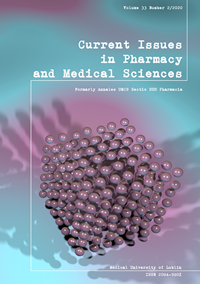Flow rate effect on partially modified potato starch microspheres formation process
DOI:
https://doi.org/10.2478/cipms-2020-0015Keywords:
biopolymer, starch, alginate, glycerol, rheology, microfluidic, microsphereAbstract
Natural biopolymers are the most likely choice for biomedical applications, and starches can be considered the best materials for such applications. This comes from the fact of their natural origin and their high biodegradable behavior. Native starches have weak hydrogen bonding and a leaching behavior – making it a candidate for drug delivery application. Still, to make starch useful as a drug delivery carrier, this hydrogen bonding must be strengthened. In this work, native sweet potato starch was used, and the hydrogen bonding between starch molecules was enhanced by introducing glycerol as a hydrogen bonding source and sodium alginate (SA) as a thickener. This blend was tested by means of FTIR and DSC, and based on the test results, improved hydrogen bonding had taken place. Furthermore, potato starch microspheres were successfully produced at different flow rates. In the work, a microfluidic capillary device was harnessed to form microsphere generating total flow rates ranging between (0.00031 and 0.00054) cm3/sec. Herein, a starch/sodium alginate/glycerol mixture was used as a dispersed phase and PVA+tween 80 was used as continuous phase. At high flow rates (0.00062-0.00054) cm3/sec, the microspheres took an oval shape. At flow rates (0.00034-0.00048) cm3/sec, the microspheres took a spherical shape. At very low flow rate (0.00031) cm3/sec, the microspheres shell was weak and caused core oozing. In this work, starch microspheres were successfully formed with diameter ranging from (151-263) µm.
References
1. Costeux A. Water in water emulsions : phase separation and rheology of biopolymer solutions. Rheol Acta. 2001;40;441-56.
2. Kim KK, Pack DW. Microspheres for Drug Delivery. BioMEMS Biomed Nanotechnol. 2006:19-50.
3. Parker R, Ring SG. Aspects of the physical chemistry of starch. J Cereal Sci. 2001;34:1-17.
4. Singh N, Singh J, Kaur L, Sodhi NS, Gill BS. Morphological, thermal and rheological properties of starches from different botanical sources. Food Chem. 2003;81(2):219-31.
5. Li J, Yeh A Relationships between thermal, rheological characteristics and swelling power for various starches. J Food Eng. 2002;50(3):141-8
6. Hou L, Wu P. Exploring the hydrogen-bond structures in sodium alginate through two- dimensional correlation infrared spectroscopy. Carbohyd. Polym. 2019;205:420-6.
7. Liang J, Ludescher RD. Effects of glycerol on the molecular mobility and hydrogen bond network in starch matrix. Carbohyd Polym. 2015;115:401-7.
8. Ward T, Faivre M, Abkarian M, Stone HA. Microfluidic flow focusing: Drop size and scaling in pressure versus flow-rate-driven pumping. Electrophoresis. 2005;26(19):23716-24.
9. Garstecki P, Gitlin I, Diluzio W, Whitesides GM, Kumacheva E, Stone HA. Formation of monodisperse bubbles in a microfluidic flow-focusing device. Appl Phys Lett. 2004;85(13):2649-51.
10. Hou L, Wu P. Exploring the hydrogen-bond structures in sodium alginate through two- dimensional correlation infrared spectroscopy. Carbohydr Polym. 2019;205:420-6.
11. Ward T, Faivre M, Abkarian M, Stone HA. Microfluidic flow focusing: Drop size and scaling in pressure versus flow-rate-driven pumping. Electrophoresis. 2005;19(26):3716-24.
12. Kuptsov AH, Zhizhin GN. Handbook of fourier transform raman and infrared spectra of polymers; 1998.
13. Sarifuddin NASN, Zaki HHM, Azhar AZA. The effect of glycerol addition to the mechanical properties of the thermoplastic films based on jackfruit seed starech. Malaysian J Anal Sci. 2018;22(5):5:892-8.
14. Pagliaro BM, Rossi M, Pagliaro M. Glycerol: Properties and Production In: The Future of Glycerol: New Uses of a Versatile Raw Material; 2008:1-18.
15. Taha MO, Aiedeh KM, Al-hiari Y, Alkhatib HS. Synthesis of zinc-crosslinked thiolated alginic acid beads and their in vitro evaluation as potential enteric delivery system with folic acid as model drug. Pharmazie. 2005:60.
16. Labs BE. More solutions to sticky problems (A guide to getting more from your Brookfield Viscometer and Rheometer); 2014.
17. Adzima BK, Velankar SS. Pressure drops for droplet flows in microfluidic channels. J Micromech Microeng. 2006;16(8):1504-10.
18. Ham D, Lee H, Westervelt RM. Introduction to fluid dynamics for microfluidic flows. In: CMOS Biotechnology. Springer Ltd; 2007:5-30.
19. Holmes DP. Confined fluid flow: Microfluidics and capillarity. Uni Roma; 2015.
20. Slapar V. Microfluidics. University of Ljubljana; 2008.
21. Gu H, Duits MHG, Mugele F. Droplets formation and merging in two-phase flow microfluidics. Int Mol Sci. 2011;12(4) 2572-97.
22. Macosko CW. Rheology: Principles, Measurements and Applications. Wiley-VCH, Inc; 1994.
Downloads
Published
Issue
Section
License
Copyright (c) 2020 Authors

This work is licensed under a Creative Commons Attribution-NonCommercial-NoDerivatives 3.0 Unported License.


